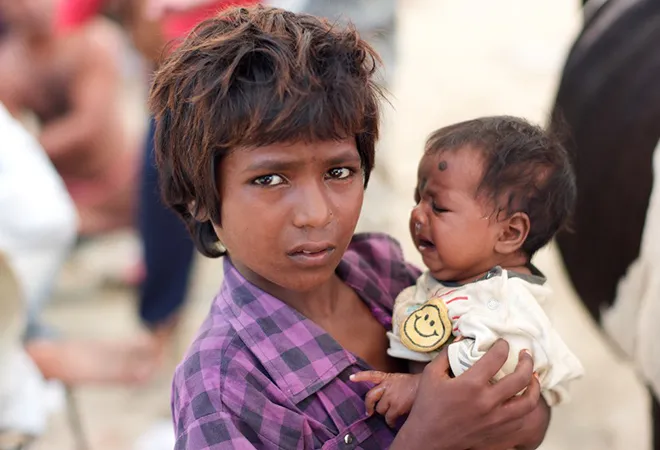
Haridwar, also described as
Gateway to Gods, is well known for its rich culture, history and natural environment. It is well-endowed with lush green forests and is one of the first towns where Ganga emerges from the mountains to touch the planes. Consequently, the district has plenty of water resources for agricultural and other developmental activities. But despite its geographical advantages and high economic status represented as
highest per capita Net State Domestic Product, Haridwar has significantly worse health indicators when compared to other districts of Uttarakhand.
Social demographics
Haridwar, home to about
one-fifth of the Uttarakhand’s population of over 10 million people, goes to polls on February 15. With largest electorate share (
13 lakhs) of around 48% as females, will issues concerning women play a decisive role? Here is a peek at how the largest and most famous district in the State performs on key health indicators. Unlike other districts of the State, Haridwar’s population is comprised of 64% Hindus, 34% Muslims and one percent Sikhs. The sex ratio — females per 1000 males — for the district has always been significantly
lower than the State. The gap between male and female literacy rates is over
16 per cent in the district as a whole.
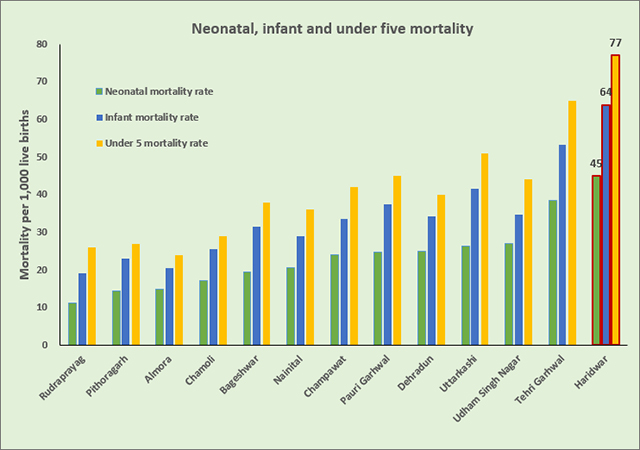
High child mortality
If mortality can be regarded as an
indicator of economic success or failure, then Haridwar clearly is an underperformer. The AHS
data shows that Haridwar has the highest level neonatal (45), infant (64) and under-five mortality (77) rates per 1,000 live births when compared to the other districts. In fact, there are huge inter-district disparities and Haridwar is at the receiving end of such inequalities. For instance, Haridwar’s neonatal mortality rate is 4 times higher than Rudraprayag district and its infant and under-five mortality rates are three times higher than Rudraprayag.
Poor female survival in rural areas
A typical aspect of child mortality pattern in Haridwar is that females have lower odds of survival with high female mortality figures (
75 infant mortality rate and 96 under five mortality rate for rural Haridwar) and sex ratio at birth (773 per 1000 males for urban Haridwar) is not in their favour. Such wide gender-differential in survival is rare across districts. The pattern is also in stark contrast with the survival experience where male children have marginal advantage.
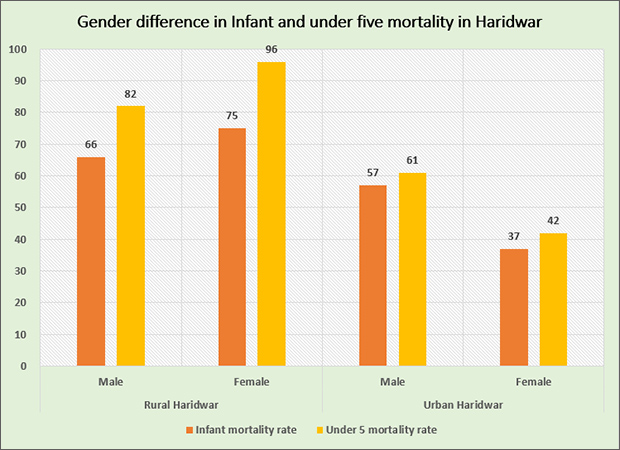
High neonatal mortality
Neonatal mortality is a major concern and constitutes for about 70% of the total infant deaths. Thus tracking high-risk pregnancies and supporting them through effective antenatal and postnatal care is essential to bring faster reductions in child mortality in Haridwar. Also, causes of neonatal deaths should be identified for improving policies toward child survival.
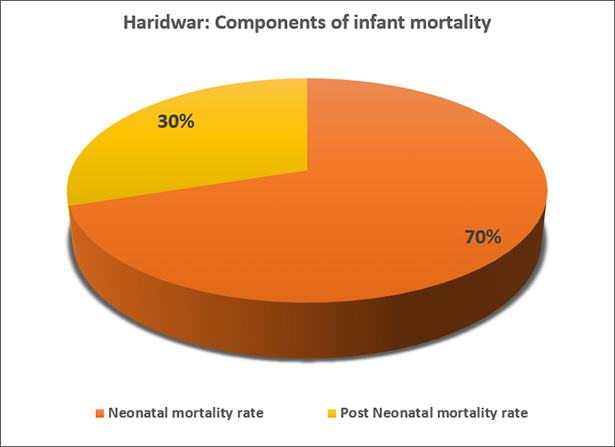
Outlier in health performance
Compared to other districts, Haridwar is an outlier in health performance from several perspectives. Full antenatal care, institutional care during delivery and full immunization are key health system interventions which can help reduce infant mortality. The AHS
data shows that only one in six pregnant women received full ANC in Haridwar which comprises of three visits to health facility, at least one TT injection and iron and folic consumption for 100 days or more. But the number from a more recent survey of National Family Health Survey (2015-16) is even lower at one in thirteen pregnant women receiving antenatal care.
As per NFHS 2015-16, Haridwar (63%) has much lower level of institutional delivery when compared to its neighbour Dehradun (84%) or other plain district such as Udham Singh Nagar (68%). Since one-fifth of the state population resides in Haridwar, it also pulls down the state performance.
Receipt of basic vaccines can help reduce the burden of preventable deaths among infants and children. However, among the districts, Haridwar has the lowest full immunization coverage of 55% and is same for the state average of 58% but it’s far below the best performing Pithoragarh at 74%. This partly reflects in the form of high infant mortality which is again way higher than other districts in the state.
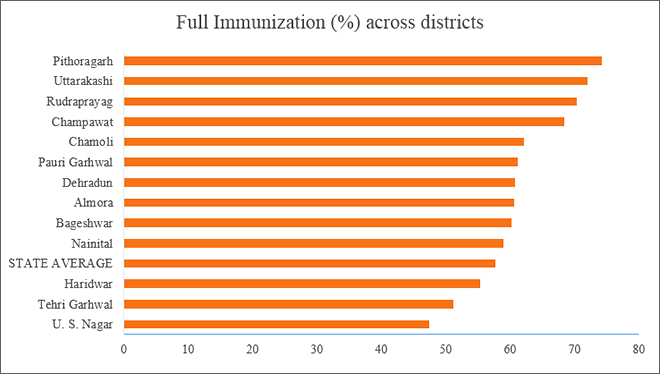
Why is Haridwar an outlier?
Being located in plains and with good transport infrastructure, Haridwar should not face challenges regarding effective public health system, especially with regards to desirability of medical postings and availability of human resources for health. Yet, the health indicators do not reflect the favourable economic geography of the district. The causes for such underperformance are aggravated through poor health system governance and other social determinants.
Undernutrition is a major concern in the district. Around one-third of all the children born have low birth weight.This is a key risk factor and adversely affects chances of child survival. Haridwar also reports very high prevalence of diarrhea (18%) which is higher than state average by one percentage point but is considered a major contributor to
child mortality in
India.
Haridwar has the highest total fertility rate of 2.7 whereas most other districts are either below or around replacement level fertility rate of 2.1. With
widespread undernutrition and low mean age at marriage, such high number of births per women elevates the biological risk of low birth weight, undernutrition and mortality among children. Also, the chances of proper and systematic care is reduced.
The
Rural Health Statistics show that in Uttarakhand more than 50% of the sanctioned doctor positions (about 165 doctors) at primary health centers are lying vacant. The situation is worse in case of medical specialists as over 75% posts (148 surgeons, obstetricians, gynecologists, physicians and paediatricians) are vacant across state community health centres. Much of these state-wide vacancies are also expected to affect service provisioning across rural Haridwar.
Time for health governance
The
budget 2017 has earmarked resources as per the announcements made by the
Prime Minister for increased financial support for pregnant women. Such increased allocations in the health and related sectors can go a long way in achieving faster reduction in infant mortality and undernutrition in high burden districts like Haridwar.
However, the state and the district needs a vision on health governance. A first priority should be to ensure availability of doctors and specialists as per the sanctioned numbers. Availability and quality of diagnostic services and medical care at public health facilities is another major area for good governance.
Steps to manage premature births and avoid newborn infections through improved hygiene and proper obstetric management is
critical. Improving access to institutional care during births is another important aspect as in times of emergency home-based births suffer from huge disadvantages ranging from lack of medical expertise to lack of resources. Community health services should be strengthened to
avoid infant deaths due to lack of referral, transportation, unavailability of low-cost health services and ignorance.
Given the dismal health indicators of Haridwar, the district has to undergo serious policy discussions if it aims to achieve the sustainable development goals. In particular, the immediate priority of the district should be to contribute toward the target specified under national action plan for reducing India’s infant mortality to 29 by 2019. Only good health governance can bring Haridwar closer to this target.
The views expressed above belong to the author(s). ORF research and analyses now available on Telegram! Click here to access our curated content — blogs, longforms and interviews.



 Haridwar, also described as
Haridwar, also described as 



 PREV
PREV


